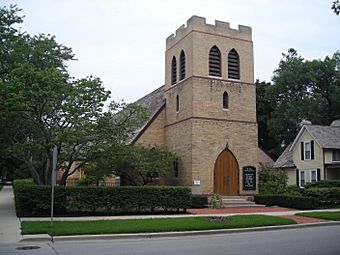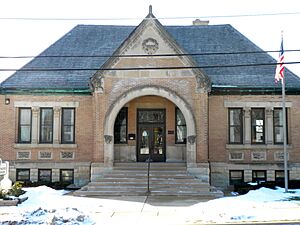Dundee Township Historic District facts for kids
Quick facts for kids |
|
|
Dundee Township Historic District
|
|

St. James Episcopal Church in West Dundee
|
|
| Location | Both sides of Fox River, including sections of E. Dundee, W. Dundee, and Carpentersville, Illinois |
|---|---|
| Architectural style | Queen Anne, Italianate, Greek Revival |
| NRHP reference No. | 75000666 |
| Added to NRHP | March 7, 1975 |
The Dundee Township Historic District is a special collection of sixty-five buildings. You can find these buildings in Dundee Township, Kane County, Illinois. They are located in the towns of East Dundee, West Dundee, and Carpentersville. This district shows how the upper Fox River Valley grew between 1870 and the 1920s.
Dundee Township became an important place for factories and businesses. This happened especially after the Dundee Brick Company opened in West Dundee and the Illinois Iron and Bolt Company started in Carpentersville. The district also includes many homes built in the Queen Anne, Italianate, and Greek Revival styles. You'll also see churches built in the Gothic Revival style. Most of this historic area is located in West Dundee. It was added to the National Register of Historical Places in 1975.
Contents
History of the Dundee Township Historic District
West Dundee was first settled in 1834 by Jesse H. Newman. Soon after, Joseph Russell, who traveled with Newman, built his house on the east side of the Fox River. This made him the first settler of East Dundee. Charles W. and Daniel G. Carpenter settled in what would become Carpentersville in 1837.
Both East and West Dundee had their town plans (called a plat) drawn up in the early 1840s. Carpentersville's plan was made in 1851. The Dundee Brick Company was a big employer early on, starting in 1852. West Dundee officially became a town in 1867, and East Dundee followed four years later. The Illinois Iron and Bolt Company opened in Carpentersville in 1870. Making dairy products became an important way for East and West Dundee to earn money in the 1870s. The historic district mainly shows buildings from 1870 to the 1920s.
Buildings in West Dundee
Most of the historic buildings are in West Dundee. The Dundee Cemetery was first used in 1841, but it didn't officially become a cemetery until 1862. A Baptist church was built in 1865. It was later sold to the Methodist church. Union School was first built in 1873, but a fire destroyed it five years later. It was rebuilt that same year with the same design. Today, School District #300 uses it.
Many important businesses opened along Main Street starting in the 1870s. These included the First National Bank, Dundee State Bank, the Cleveland Drug Store, and the Dundee House Hotel. The First Congregational Church was also built here in 1902. The Bethlehem Lutheran Church followed in 1912. St. James Episcopal Church was built in 1904 for the local Episcopalian community. In 1909, West Dundee built its Village Hall. St. Catherine's Catholic Church (1914) and its school (added 1926) were important for Italian immigrants working at the Illinois Iron and Bolt Company.
Buildings in East Dundee
In East Dundee, the Spring Mill was first built in 1837. Today, only one large black storage building from the mill remains. Most of the mill was taken down after it faced difficulties during a tough economic time called The Great Depression. The Haeger Pottery Plant was built in 1871 for David H. Haeger. It first made bricks for Chicago after The Great Chicago Fire. Later, it started making beautiful art pottery. Immanuel Lutheran Church was built in 1886 for German immigrants. It had the most members in Dundee Township.
Buildings in Carpentersville

The Atlantic Flour Mills, built in 1846, are the oldest buildings in Carpentersville. The Illinois Iron and Bolt Company building from 1871 was one of the town's main employers. The Star Manufacturing Company was built in the early 1870s. It made farm tools and machinery. The Carpenter Store was built in 1877 and belonged to the Carpenter family. Union Church Congregational and Parsonage was a gift from Angelo and Mary Carpenter. It was built in 1884. Library Hall was built in 1895 to honor Angelo Carpenter. It is also listed on the National Register of Historical Places on its own.
Architectural Styles
The earliest homes in the district show some Greek Revival style. As more people moved to the valley in the 1880s, Italianate homes became very popular. Another important style for homes in the district is Queen Anne. There is one large Georgian Revival house that later became a bank. Most churches in the district are in the Gothic Revival style. The factories are designed in the Queen Anne and Renaissance Revival styles. Most buildings were made with bricks from the Dundee Brick Company. These bricks are special because of their unusual yellow color. The Dundee Township Historic District was added to the National Register of Historical Places on March 7, 1975.
Images for kids
-
Library Hall, in Carpentersville, is individually listed on the National Register of Historic Places.






